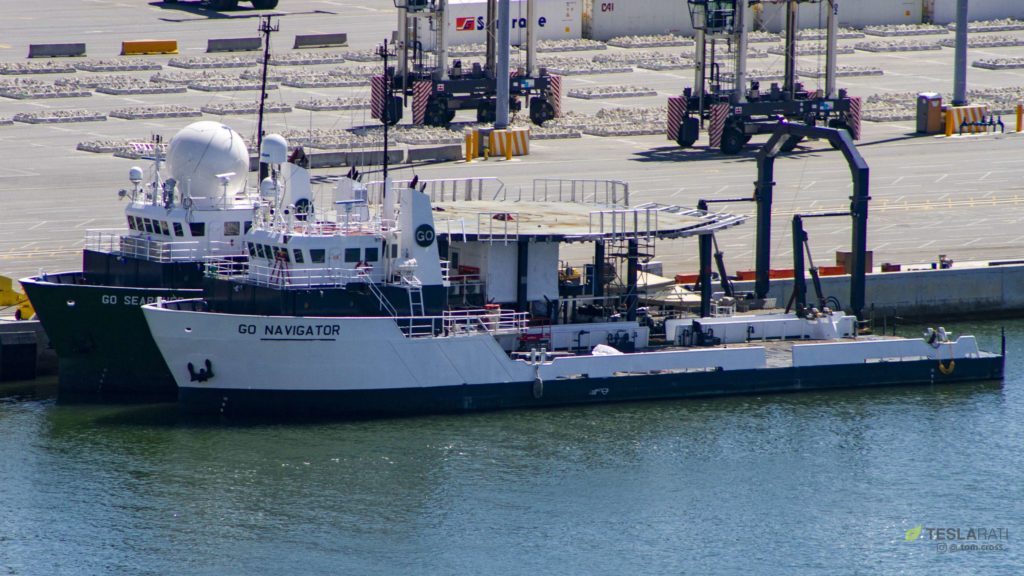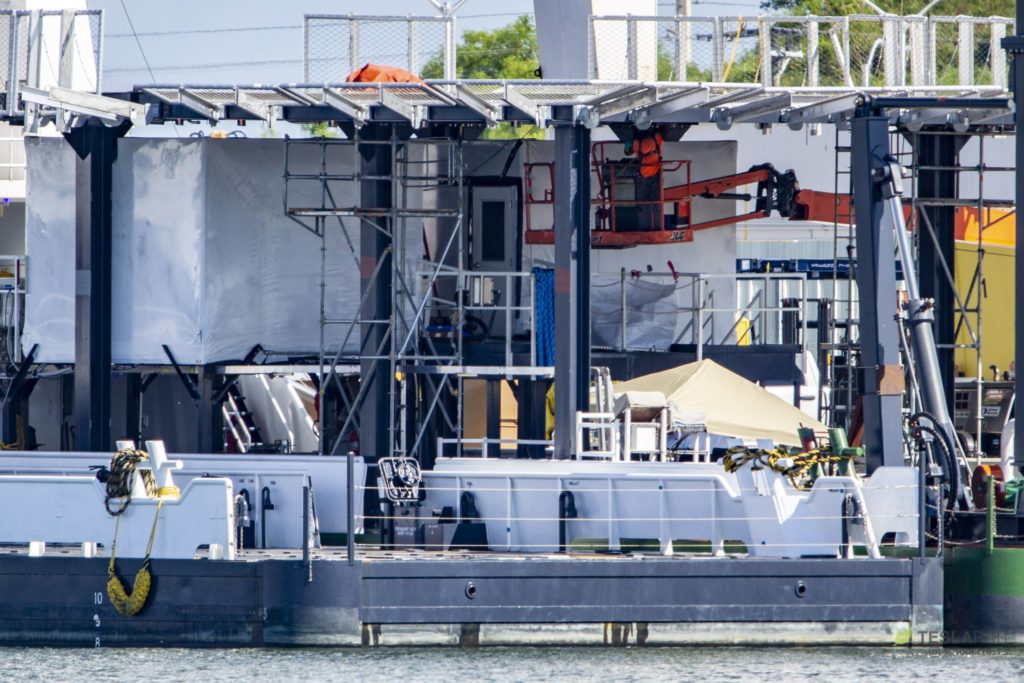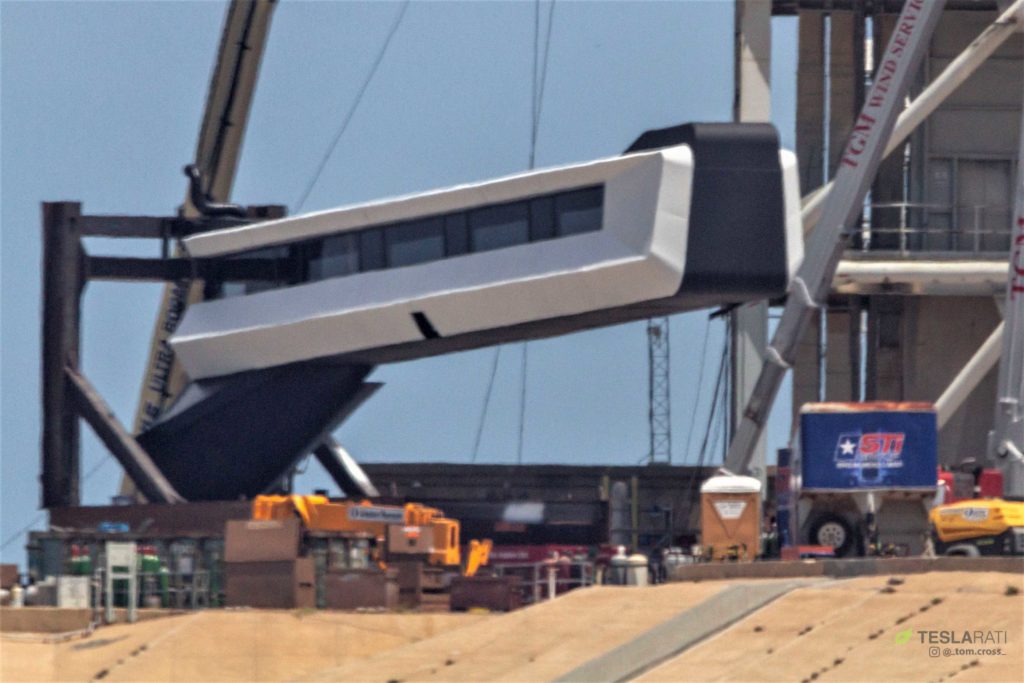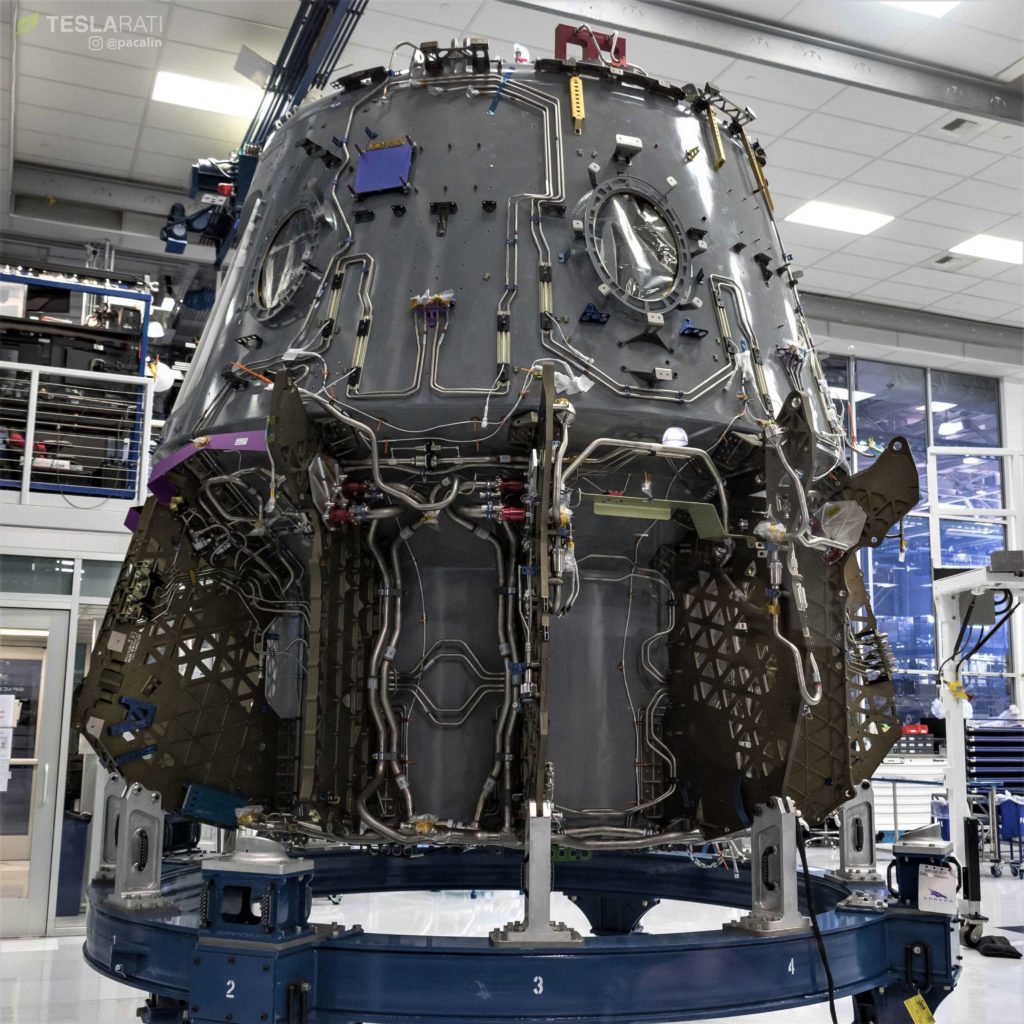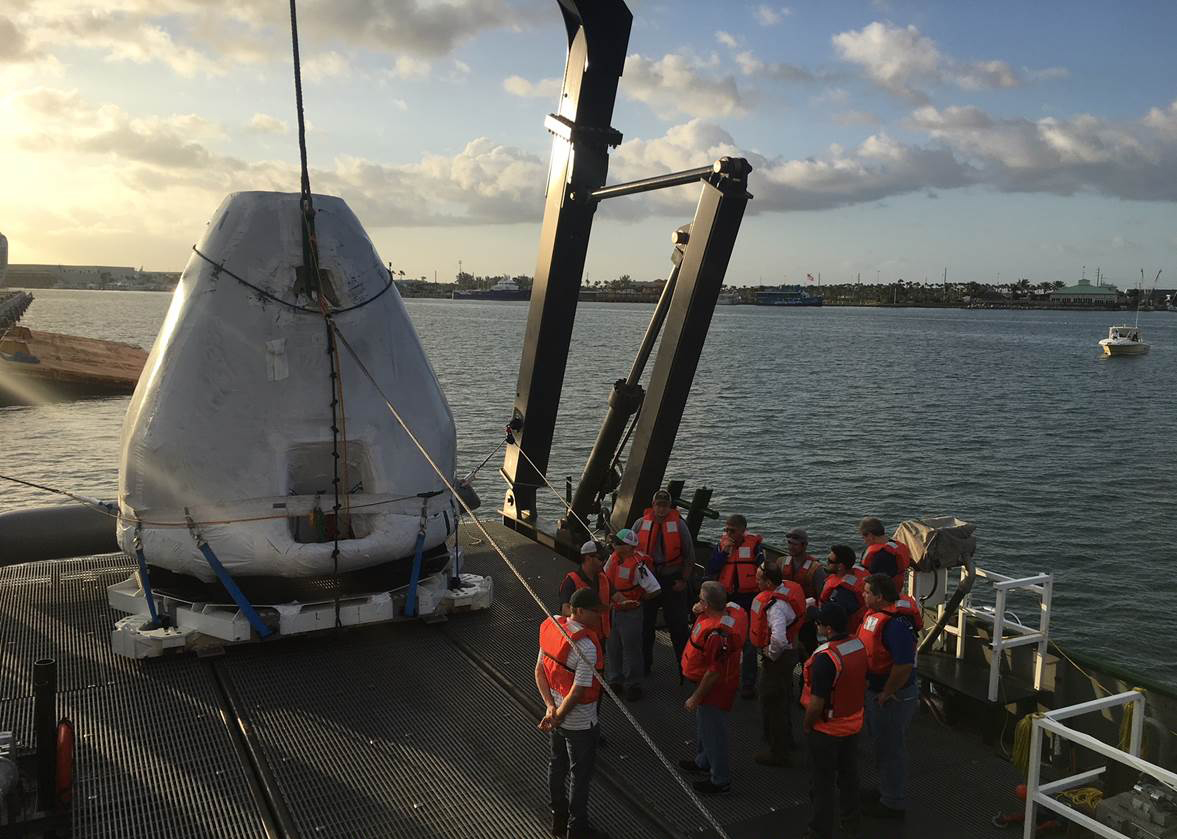
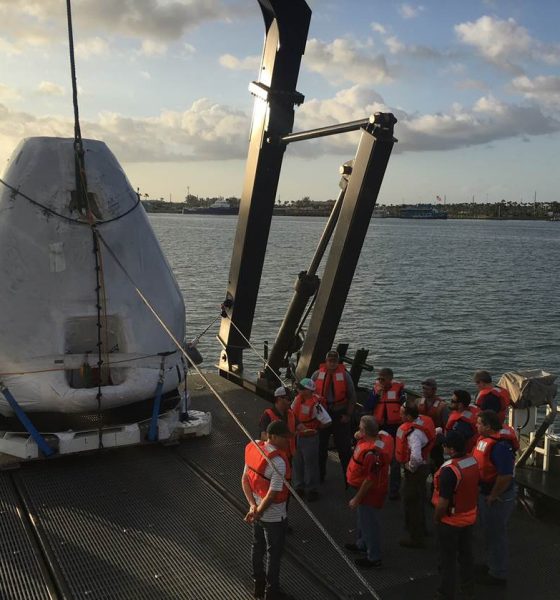
News
SpaceX’s Crew Dragon spacecraft recovery ship gets a helipad prior to launch debut
SpaceX’s primary Crew Dragon recovery vessel GO Searcher is undergoing a number of modifications in preparation for inaugural demonstrations flights of the company’s first human-rated spacecraft.
Most notably, GO Searcher is being fitted with a helipad that will be used to rapidly transfer astronauts from Crew Dragon to Cape Canaveral, where they will go through a number of medical evaluations and debriefings after a six-month stay in orbit aboard the International Space Station (ISS).
- GO Searcher’s new helipad has been rapidly constructed over the last two months. (Tom Cross – 08/12/18)
- A construction worker helps provide a sense of scale for the new pad. (Tom Cross – 08/12/18)
Over the last year or so, the long-time member of SpaceX’s East Coast rocket recovery fleet has been gradually receiving upgrades and conducting sea trials and mockup Dragon recovery tests, performed in concert with the US Air Force and NASA. Once Commercial Crew missions start launching in earnest, GO Searcher will be SpaceX’s sole Crew Dragon spacecraft and astronaut recovery vessel, a new mission that required a number of visible modifications.
Three of those upgrades are especially obvious. First, a large helipad (pictured above) is being constructed on GO Searcher’s deck. That helipad is a critical addition that will enable the rapid transport of astronauts, recovery experts, technicians, doctors, and more (perhaps even press) to or from the ship, which will be at most a few hundred kilometers east of the Florida Coast during Dragon recovery operations, and likely closer to a few tens of kilometers.
.@SpaceX's East Coast #Dragon space capsule recovery vessel, GO Searcher, has finally reemerged after being off-grid past 10-days. Appears to be sporting new hardware. #SpaceXArmada #CrewedDragon 📷: St John's Ship Yard, Palatka FL pic.twitter.com/CPR3P6DoWB
— Cowboy Dan (@CowboyDanPaasch) July 4, 2018
The next most obvious change to GO Searcher is a massive dome, likely dedicated to radar, Crew Dragon communications, or both. That dome and communications/radar array were installed over a several-week maintenance period spent at an East Coast drydocks facility, wrapping up with an early-July return to SpaceX’s Port Canaveral dock space.
Last but not least is the large metal structure at GO Searcher’s rear, a custom-built hydraulic lift designed specifically to lift Crew Dragon onto the recovery vessel’s deck. SpaceX has been extensively testing Dragon recovery operations with that particular rig throughout 2018, working with Commerical Crew astronauts, US Air Force representatives, and NASA officials to ensure that the orchestration of those Dragon and crew recovery operations are down to reflex by the time technicians are called upon to perform the same tasks with real humans and hardware.
- SpaceX has rolled its completed Crew Dragon Access Arm into position and is just days away from installing the sleek arm. 08/16/18 (Tom Cross)
- SpaceX Crew Dragon capsule C203 – then assigned DM-2 – is seen here in August 2018. (Pauline Acalin)
- The first spaceworthy Crew Dragon capsule is already in Florida, preparing for its November 2018 launch debut. The same capsule will be refurbished and reflown as few as three months after recovery. (SpaceX)
- On February 28, SpaceX completed a demonstration of their ability to recover the crew and capsule after a nominal water splashdown in the Atlantic Ocean, just off the coast of Florida. (SpaceX)
- Dragon recovery technicians wrap up a busy day of demonstrations aboard GO Searcher, March 2018. (SpaceX)
SpaceX’s first uncrewed demonstration launch of Crew Dragon is scheduled for no earlier than November 2018, a date President and COO Gwynne Shotwell expressed considerable confidence in earlier this month. That spacecraft may end up landing on a giant inflatable cushion in order to ease refurbishment, as the same capsule will be reflown just a few months later for SpaceX’s in-flight abort test, designed to ensure that astronauts can be safely pulled away from a failing rocket at all points during launch.
Pending a successful uncrewed demo and in-flight abort test, SpaceX could become the first private company in history to launch humans into Earth orbit as early as April 2019.
For prompt updates, on-the-ground perspectives, and unique glimpses of SpaceX’s rocket recovery fleet check out our brand new LaunchPad and LandingZone newsletters!

Elon Musk
Elon Musk confirms xAI’s purchase of five 380 MW natural gas turbines
The deal, which was confirmed by Musk on X, highlights xAI’s effort to aggressively scale its operations.

xAI, Elon Musk’s artificial intelligence startup, has purchased five additional 380 MW natural gas turbines from South Korea’s Doosan Enerbility to power its growing supercomputer clusters.
The deal, which was confirmed by Musk on X, highlights xAI’s effort to aggressively scale its operations.
xAI’s turbine deal details
News of xAI’s new turbines was shared on social media platform X, with user @SemiAnalysis_ stating that the turbines were produced by South Korea’s Doosan Enerbility. As noted in an Asian Business Daily report, Doosan Enerbility announced last October that it signed a contract to supply two 380 MW gas turbines for a major U.S. tech company. Doosan later noted in December that it secured an order for three more 380 MW gas turbines.
As per the X user, the gas turbines would power an additional 600,000+ GB200 NVL72 equivalent size cluster. This should make xAI’s facilities among the largest in the world. In a reply, Elon Musk confirmed that xAI did purchase the turbines. “True,” Musk wrote in a post on X.
xAI’s ambitions
Recent reports have indicated that xAI closed an upsized $20 billion Series E funding round, exceeding the initial $15 billion target to fuel rapid infrastructure scaling and AI product development. The funding, as per the AI startup, “will accelerate our world-leading infrastructure buildout, enable the rapid development and deployment of transformative AI products.”
The company also teased the rollout of its upcoming frontier AI model. “Looking ahead, Grok 5 is currently in training, and we are focused on launching innovative new consumer and enterprise products that harness the power of Grok, Colossus, and 𝕏 to transform how we live, work, and play,” xAI wrote in a post on its website.
Elon Musk
Elon Musk’s xAI closes upsized $20B Series E funding round
xAI announced the investment round in a post on its official website.

xAI has closed an upsized $20 billion Series E funding round, exceeding the initial $15 billion target to fuel rapid infrastructure scaling and AI product development.
xAI announced the investment round in a post on its official website.
A $20 billion Series E round
As noted by the artificial intelligence startup in its post, the Series E funding round attracted a diverse group of investors, including Valor Equity Partners, Stepstone Group, Fidelity Management & Research Company, Qatar Investment Authority, MGX, and Baron Capital Group, among others.
Strategic partners NVIDIA and Cisco Investments also continued support for building the world’s largest GPU clusters.
As xAI stated, “This financing will accelerate our world-leading infrastructure buildout, enable the rapid development and deployment of transformative AI products reaching billions of users, and fuel groundbreaking research advancing xAI’s core mission: Understanding the Universe.”
xAI’s core mission
Th Series E funding builds on xAI’s previous rounds, powering Grok advancements and massive compute expansions like the Memphis supercluster. The upsized demand reflects growing recognition of xAI’s potential in frontier AI.
xAI also highlighted several of its breakthroughs in 2025, from the buildout of Colossus I and II, which ended with over 1 million H100 GPU equivalents, and the rollout of the Grok 4 Series, Grok Voice, and Grok Imagine, among others. The company also confirmed that work is already underway to train the flagship large language model’s next iteration, Grok 5.
“Looking ahead, Grok 5 is currently in training, and we are focused on launching innovative new consumer and enterprise products that harness the power of Grok, Colossus, and 𝕏 to transform how we live, work, and play,” xAI wrote.
Investor's Corner
Tesla gets price target bump, citing growing lead in self-driving

Tesla (NASDAQ: TSLA) stock received a price target update from Pierre Ferragu of Wall Street firm New Street Research, citing the company’s growing lead in self-driving and autonomy.
On Tuesday, Ferragu bumped his price target from $520 to $600, stating that the consensus from the Consumer Electronics Show in Las Vegas was that Tesla’s lead in autonomy has been sustained, is growing, and sits at a multiple-year lead over its competitors.
CES 2026 validates Tesla’s FSD strategy, but there’s a big lag for rivals: analyst
“The signal from Vegas is loud and clear,” the analyst writes. “The industry isn’t catching up to Tesla; it is actively validating Tesla’s strategy…just with a 12-year lag.”
The note shows that the company’s prowess in vehicle autonomy is being solidified by lagging competitors that claim to have the best method. The only problem is that Tesla’s Vision-based approach, which it adopted back in 2022 with the Model 3 and Model Y initially, has been proven to be more effective than competitors’ approach, which utilizes other technology, such as LiDAR and sensors.
Currently, Tesla shares are sitting at around $433, as the company’s stock price closed at $432.96 on Tuesday afternoon.
Ferragu’s consensus on Tesla shares echoes that of other Wall Street analysts who are bullish on the company’s stock and position within the AI, autonomy, and robotics sector.
Dan Ives of Wedbush wrote in a note in mid-December that he anticipates Tesla having a massive 2026, and could reach a $3 trillion valuation this year, especially with the “AI chapter” taking hold of the narrative at the company.
Ives also said that the big step in the right direction for Tesla will be initiating production of the Cybercab, as well as expanding on the Robotaxi program through the next 12 months:
“…as full-scale volume production begins with the autonomous and robotics roadmap…The company has started to test the all-important Cybercab in Austin over the past few weeks, which is an incremental step towards launching in 2026 with important volume production of Cybercabs starting in April/May, which remains the golden goose in unlocking TSLA’s AI valuation.”
Tesla analyst breaks down delivery report: ‘A step in the right direction’
Tesla has transitioned from an automaker to a full-fledged AI company, and its Robotaxi and Cybercab programs, fueled by the Full Self-Driving suite, are leading the charge moving forward. In 2026, there are major goals the company has outlined. The first is removing Safety Drivers from vehicles in Austin, Texas, one of the areas where it operates a ride-hailing service within the U.S.
Ultimately, Tesla will aim to launch a Level 5 autonomy suite to the public in the coming years.
